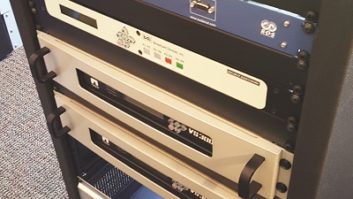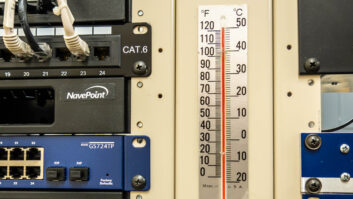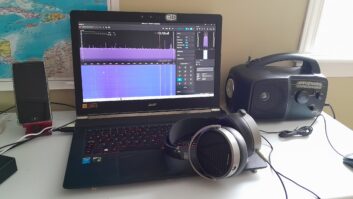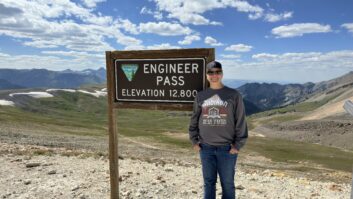Reid Fletcher is with the University of Wyoming broadcast engineering department. Not long ago, he was at a new site, pointing a dish for their Ku feed. For curiosity’s sake, Reid decided to experiment with a device he keeps with his laptop.
Reid is an amateur radio operator (WB7CJO) and has been experimenting with software-defined radio for several years. He was introduced to SDR by a friend who is an EE professor at UW and encouraged Reid to purchase a small digital video broadcasting-terrestrial dongle. These DVB-T dongles are USB devices that are intended to be DVB-T, FM and HDTV tuners but have a mode where they become essentially an A to D converter with a local oscillator and mixer for a tunable front-end and to output an I-Q data stream. From that point, it’s up to software to do something productive with the data.
The dongles are available on e-Bay, typically for $20 or less. Software is available on the Web to download and can be accessed free in some cases. Fig. 1 is a screenshot showing a pilot carrier display.

A few years back, Reid and then-Engineering Director Shane Toven were on an engineering trip when they got word from the studio that a listener reported one of the stations (KUWA) was off the air. Arriving at the troubled station, they found there was no audio from the Ku receiver. For various reasons, they had not brought a spectrum analyzer on this trip, so Reid pulled out his DVB-T dongle. After plugging it into his laptop’s USB port and firing up the software, he and Shane could see there was no signal from the LNB. Replacing the LNB returned KUWA to the air.
A $20 dongle and a laptop provided a quick tool that solved the off-air problem in a pinch. Though this is not a serious measurement instrument, it proved useful for some quick troubleshooting. It’s a “must-have” for contract engineers or those who maintain a lot of translators or LPFMs.
Fig. 2 shows a screenshot of the LNB output during the dish pointing as previously described, using SDRSHARP SDR software driven by the R820T-based dongle. Reid’s signal is the fat signal at 1167.55 MHz.

Realize there is no calibration, so these pictures aren’t worth a thousand words, but in a pinch, you just might use the display to get back on the air!
****
Kuala Lumpur-based broadcast engineer Paul Sagi sends in this helpful link: www.shortcutworld.com/en/win/Windows_8.html.
Shortcutworld is a wiki-style reference data base to keyboard shortcuts. The link above will take you to the Windows 8 shortcuts but the site includes shortcuts for operating systems from Windows XP to Windows 10. Plus, there are Mac Operating System shortcuts and even shortcuts for Linux users.
Paul also writes about a new technology, Wi-FM, which uses FM signals to speed up your computer and reduce the interference problems that overlapping Wi-Fi channels cause. Routers negotiate to take turns when there is co-channel (same channel) interference, whereas overlapping channels just jam each other.
Paul’s recommendation is to choose a channel manually, instead of using the router’s automatic channel selection. He suggested Channel 1, 6 or 11 because they don’t overlap each other. Choose the channel least overlapped by other channels. In conclusion, Paul says to avoid Channel 9; microwave ovens use that frequency.
****
Any broadcast engineer knows the RF spectrum is getting crowded, which is having an adverse effect on FM/AM radio reception, specifically for HD signals.
The DX Engineering AFHD-4 antenna is a purpose-built AM/FM/HD receive antenna designed for audiophile-grade and vintage radios. The antenna is also a great option for community-antenna applications, like those found in retail stores and apartment complexes. It improves analog signal reception and mitigates annoying HD digital phasing issues and “drop outs.”
The AFHD-4 boasts an omnidirectional receive pattern, with 520–1620 kHz (AM) and 88–108 MHz (FM) coverage. It features a slim, low-profile vertical design, yet achieves impressive gain on both the AM and FM bands.
Testing demonstrated the following typical receive ranges (range is dependent upon broadcast station transmit power):
• FM stereo, 80 miles
• FM digital, 50 miles
• AM mono, 90 miles
• AM digital, 50 miles
Better still, the antenna is served by a single run of RG-6 coaxial cable, sold separately. The antenna package includes a splitter that sends each signal to the appropriate antenna port. This simplifies installation and keeps cable runs neat and tidy.
The DX Engineering AFHD-4 AM/FM/HD comes with the 4-foot antenna, the AM/FM band splitter and a coax to twin-lead adapter. It includes a clever mounting bracket that works for both mast- and wall-mount installations. You can obtain more information from this www.dxengineering.com/parts/ins-afhd-4 or call 800-777-0703.
Contribute to Workbench. You’ll help your fellow engineers and qualify for SBE recertification credit. Send Workbench tips to [email protected]. Fax to (603) 472-4944.
Author John Bisset has spent 46 years in the broadcasting industry and is still learning. He handles West Coast sales for the Telos Alliance. He is SBE certified and is a past recipient of the SBE’s Educator of the Year Award.







